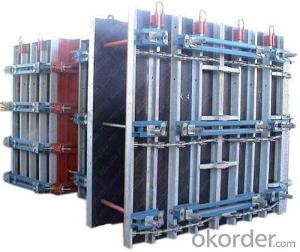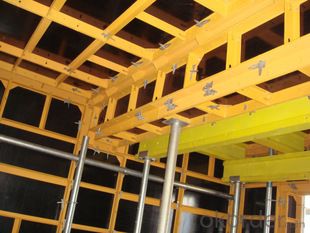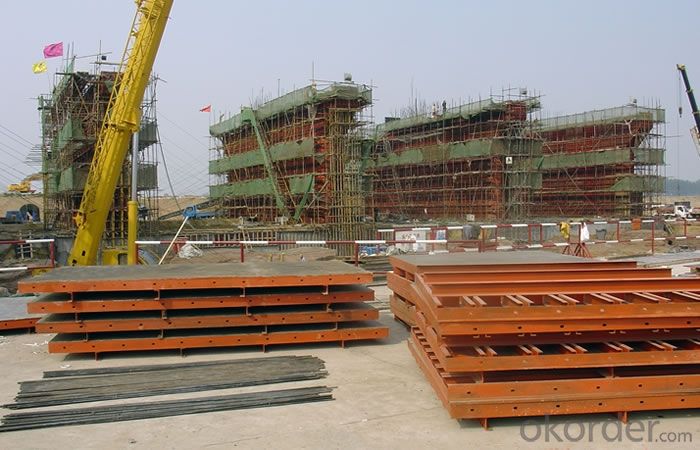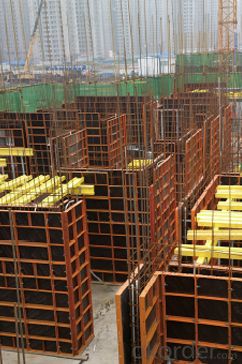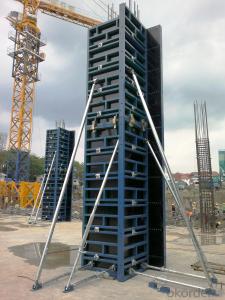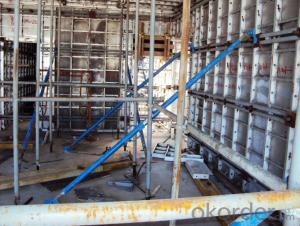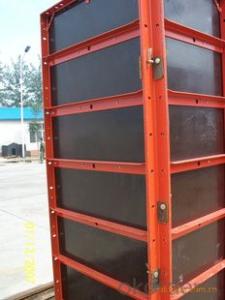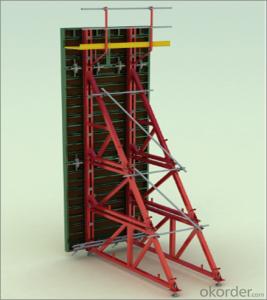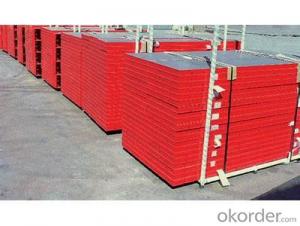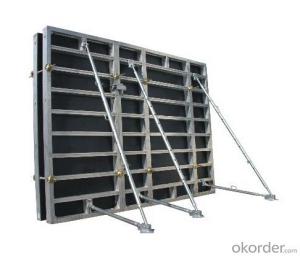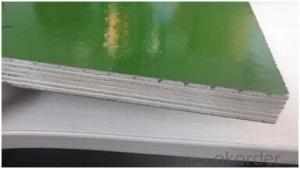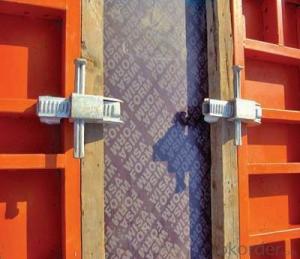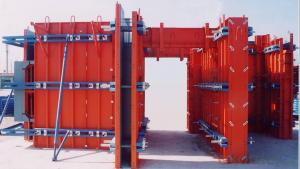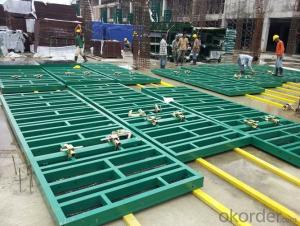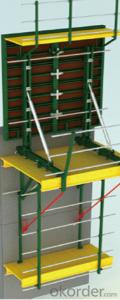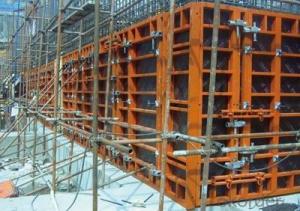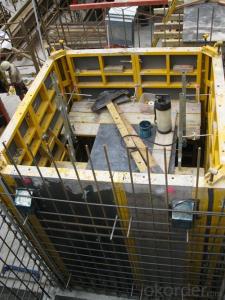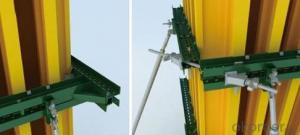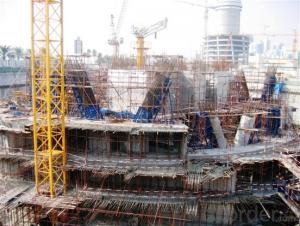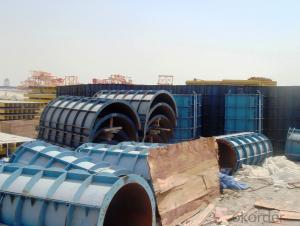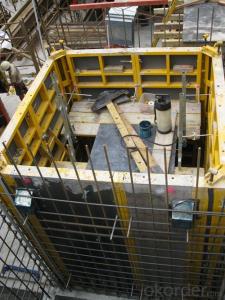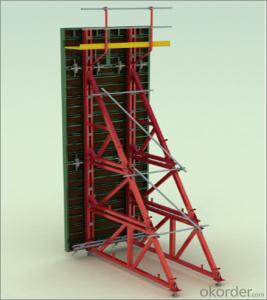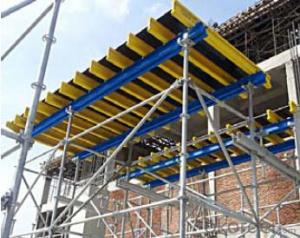Steel Frame Formwork-Column Formwork from CNBM China
- Loading Port:
- China main port
- Payment Terms:
- TT OR LC
- Min Order Qty:
- 1000 m²
- Supply Capability:
- 50000 m²/month
OKorder Service Pledge
OKorder Financial Service
You Might Also Like
1. Structure of Steel Frame Formwork
There is a prizing part designed in the corner, which can help to position and remove formwork easily.
The plywood is screwed on from the back when connecting frame and plywood, so the surface of the finished concrete is perfect.
The formwork series are a complete system with a full set of accessories, and can be set up flexibly according to project demand.
2. Main Features of Steel Frame Formwork
Light weight
High strength
High standardized system
Easy connection with adjustable steel clamp
Convenient and fast corner formwork
Flexible to assemble and application
3. Steel Frame Formwork Images
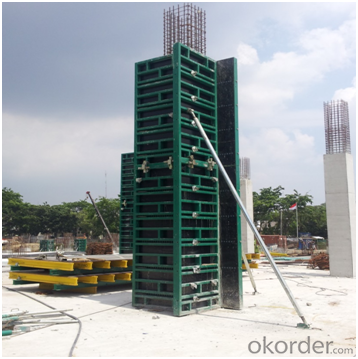
4. Steel Frame Formwork GK120 Specification
-The steel frame formwork is plywood covered with hollow steel. The plywood is 18 mm thick.
-The frame is highly strengthened, and the wall formwork can bear lateral pressure 60 KN/m2 while the column formwork can bear 80 KN/m2.
-As a standardized system, it is flexible to assemble , wood batten can be filled to satisfy the need f of non-standard size.
-The adjustable steel clamp is convenient to use, and can hold tightly.
-There is a prizing part designed in the corner, which can help to position and remove formwork easily.
-The plywood is screwed on from the back when connecting frame and plywood, so the surface of the finished concrete is perfect.
-The formwork series are a complete system with a full set of accessories, and can be set up flexibly according to project demand.
5. FAQ of Steel Frame Formwork GK120
1) What can we do for you?
.We can ensure the quality of the vinyl banner and avoid extra expenses for customers.
.We can provide you the professional design team.
.We can provide fashionable and newest styles for you.
.We can design the artwork for you.
. Please feel free to customize.
2) What promises can be done by us?
. If interested in Steel Frame Formwork GK120, please feel free to write us for any QUOTE.
. If printing required, please advise asap because the whole set need much more time to complete.
. Please DO check goods when courier knocks your door and contact us asap if any issue.
- Q: Does steel frame formwork require any specific reinforcement detailing?
- Yes, steel frame formwork does require specific reinforcement detailing. The reinforcement detailing is necessary to ensure the structural integrity and stability of the formwork system, especially during the pouring and curing of concrete. The reinforcement detailing includes the placement and spacing of steel bars, the size and type of reinforcement elements, and the connections between different components of the formwork system. Proper reinforcement detailing helps to distribute loads evenly, prevent potential cracks or failures, and enhance the longevity of the formwork.
- Q: What are the quality control measures for steel frame formwork installation?
- There are several quality control measures for steel frame formwork installation. Firstly, it is important to ensure that the steel frame formwork is manufactured according to the required specifications and standards. This can be done by conducting thorough inspections and tests on the materials and components used in the formwork. Additionally, proper training and supervision should be provided to the workers involved in the installation process to ensure that they follow the correct procedures and techniques. Regular inspections should also be carried out during the installation to check for any defects or issues that may affect the quality of the formwork. Finally, proper documentation and record-keeping should be maintained throughout the installation process to track and monitor the quality control measures taken.
- Q: Are there any restrictions on the type of reinforcement that can be used with steel frame formwork?
- Yes, there are certain restrictions on the type of reinforcement that can be used with steel frame formwork. Steel frame formwork is commonly used in construction for its durability and strength. However, it is important to ensure that the reinforcement used is compatible with the steel frame formwork system. One restriction is the size and shape of the reinforcement bars. The bars used should be able to fit within the formwork system without causing any obstruction or hindrance to the pouring and curing of the concrete. Additionally, the reinforcement bars should have proper spacing to allow for proper concrete consolidation and ensure structural integrity. Another restriction is the type of reinforcement material used. Steel frame formwork is typically designed to accommodate steel reinforcement bars, as they have similar properties and can be easily integrated into the formwork system. Other types of reinforcement materials, such as fiberglass or carbon fiber, may not be suitable for use with steel frame formwork due to differences in strength, compatibility, and bonding characteristics. It is essential to follow the manufacturer's guidelines and recommendations when selecting and installing reinforcement with steel frame formwork. This ensures that the reinforcement used is appropriate and compatible with the formwork system, thereby guaranteeing the structural stability and integrity of the construction project.
- Q: How is the quality of the concrete surface achieved with steel frame formwork?
- The quality of the concrete surface achieved with steel frame formwork is generally high due to several factors. Firstly, steel frame formwork provides a rigid and stable structure that can withstand the pressure of the fresh concrete, ensuring that it is poured and compacted evenly. This helps in preventing any irregularities or deformations in the concrete surface. Additionally, steel frame formwork is designed with various features that enhance the quality of the concrete surface. It usually includes adjustable formwork elements, such as clamps, tie rods, and spacers, which allow for precise alignment and leveling of the formwork. This ensures that the concrete is poured at the correct thickness and with consistent dimensions, resulting in a smooth and even surface. Moreover, steel frame formwork often incorporates form liners or surface treatments that can create decorative patterns or textures on the concrete surface. These liners or treatments can be easily attached to the steel frames, allowing for the creation of aesthetically pleasing finishes. Furthermore, steel frame formwork is durable and reusable, which means it can be used multiple times without compromising the quality of the concrete surface. This is particularly important in large construction projects where the same formwork needs to be used repeatedly. The consistent use of the same formwork ensures uniformity in the concrete surface quality throughout the project. In summary, the quality of the concrete surface achieved with steel frame formwork is high due to its stability, adjustability, and durability. These factors contribute to the creation of a smooth, even, and aesthetically pleasing surface that meets the required standards and specifications.
- Q: Can steel frame formwork be used for both low-rise and high-rise buildings?
- Yes, steel frame formwork can be used for both low-rise and high-rise buildings. Its strong and durable nature makes it suitable for supporting concrete during construction, regardless of the building's height.
- Q: What are the different types of form ties used in steel frame formwork systems?
- There are several types of form ties used in steel frame formwork systems, including loop ties, flat ties, wedge bolts, and snap ties. Loop ties are typically used to secure horizontal formwork elements together, while flat ties are used to secure vertical formwork elements. Wedge bolts are used to connect steel frame formwork panels, and snap ties are used to secure formwork panels to each other.
- Q: What are the different components of steel frame formwork?
- The steel frame formwork typically consists of various components: 1. Panels serve as the primary element of the system, made from steel or aluminum. They are designed to be lightweight yet sturdy, coming in different sizes, shapes, and thicknesses based on the required strength and load-bearing capacity. 2. To ensure a tight and secure formwork system, connecting pins made of steel are used to join the panels together. These pins are inserted through pre-drilled holes in the panels, providing stability and preventing any movement or displacement during concrete pouring. 3. Wedges, usually made of steel or plastic, are used in conjunction with the connecting pins to further secure the formwork system. They are inserted between the panels and pins, creating a tight fit and preventing any gaps or spaces that could lead to leakage or uneven concrete placement. 4. Props are vertical support devices made of steel, providing additional strength and stability to the formwork system. They can be adjusted in height, allowing flexibility in formwork installation. Props play a crucial role in supporting the weight of the concrete and formwork, ensuring a safe and reliable construction process. 5. Braces, made of steel, are horizontal or diagonal supports used to reinforce the formwork system and prevent any buckling or bending of the panels. They are installed at regular intervals, providing additional stability and rigidity to the formwork structure. 6. Various accessories, including clamps, ties, and brackets, may also be included in the steel frame formwork system. These accessories secure the formwork system to the existing structure, ensure accurate panel alignment, and provide additional reinforcement where necessary. Collectively, these components form a robust and reliable system for concrete construction. The combination of panels, connecting pins, wedges, props, braces, and accessories guarantees a strong and stable formwork structure capable of withstanding the pressures and forces exerted during the concrete pouring process.
- Q: What are the different types of safety features incorporated in steel frame formwork systems?
- Steel frame formwork systems commonly include various safety features to ensure worker protection and prevent accidents on construction sites. Some of the frequently seen safety features are as follows: 1. Guardrails: Guardrails are installed along the edges of the formwork to act as a physical barrier, preventing workers from falling. 2. Toe boards: At the bottom of the formwork, toe boards are installed to prevent any tools, materials, or debris from falling and potentially causing harm to workers below. 3. Safety nets: In conjunction with steel frame formwork systems, safety nets provide an additional layer of protection against falls. These nets are usually placed below the formwork to catch workers or objects in case of a fall. 4. Access platforms and ladders: Access platforms and ladders are included in steel frame formwork systems to ensure safe and easy access to the formwork. These platforms and ladders are designed to be sturdy and secure, facilitating workers to move up and down the formwork with safety. 5. Fall arrest systems: Individual protection against falls is provided by fall arrest systems, such as harnesses and safety lines, which are often used alongside steel frame formwork systems. These systems are designed to stop a fall and prevent a worker from hitting the ground. 6. Warning signs and labels: Safety on steel frame formwork systems is enhanced by incorporating warning signs and labels. These signs and labels provide vital information regarding potential hazards, safety precautions, and instructions for proper usage. Overall, the integration of these safety features in steel frame formwork systems creates a safe working environment, reduces the risk of accidents, and safeguards the well-being of workers on construction sites.
- Q: How does steel frame formwork contribute to the overall structural integrity of a building?
- Steel frame formwork contributes to the overall structural integrity of a building in several ways. Firstly, steel frame formwork provides a robust and sturdy support system for the concrete during the pouring and curing process. The rigid steel frame ensures that the formwork maintains its shape and can withstand the pressure exerted by the wet concrete. This prevents any distortion or deformation of the formwork, ensuring that the concrete is poured accurately and evenly, resulting in a consistent and strong structure. Furthermore, steel frame formwork allows for precise and accurate alignment of the concrete elements. The steel frames can be easily adjusted and leveled, ensuring that the concrete is poured in the desired position and alignment. This is crucial for maintaining the structural integrity of the building, as any misalignment or unevenness can lead to weak spots or compromised load-bearing capacity. Additionally, steel frame formwork provides excellent reusability and durability. Unlike traditional timber formwork, steel frames can be used repeatedly without deterioration or loss of strength. This not only saves costs and reduces waste but also ensures that the formwork remains structurally sound throughout multiple construction cycles. The durability of steel frame formwork contributes to the long-term stability and integrity of the building, as it can withstand various loads and environmental conditions without compromising its structural performance. Moreover, steel frame formwork allows for efficient construction processes. The modular design of the steel frames enables quick assembly and disassembly, reducing construction time and labor costs. This efficiency in construction contributes to the overall structural integrity of the building, as it minimizes the chances of errors or delays that could potentially compromise the structural strength. In summary, steel frame formwork plays a vital role in enhancing the overall structural integrity of a building. Its robustness, precise alignment, reusability, durability, and efficiency contribute to the accurate and consistent pouring of concrete, ensuring a strong and stable structure that can withstand various loads and environmental conditions.
- Q: What are the quality control measures for steel frame formwork reassembly?
- Quality control measures for steel frame formwork reassembly involve several important steps to ensure the integrity and safety of the structure. These measures are vital to guarantee the proper functioning and durability of the steel frame formwork system. Here are some key quality control measures: 1. Visual Inspection: A visual inspection should be conducted to check for any visible damages or defects in the steel frame components. This includes inspecting the welds, joints, and connections for cracks, rust, or any signs of wear and tear. 2. Dimensional Accuracy: The steel frame components should be checked for dimensional accuracy to ensure they meet the specified requirements. This involves verifying the measurements, angles, and alignments of the components to ensure they align correctly during reassembly. 3. Material Testing: Material testing is an essential quality control measure to ensure the steel used in the frame formwork meets the required standards. This may involve conducting tests such as tensile strength, hardness, and chemical composition analysis to verify the quality of the steel. 4. Connection Verification: The connections between the steel frame components need to be thoroughly checked to ensure they are secure and properly tightened. This involves inspecting bolts, nuts, and fasteners to ensure they are correctly installed and torqued to the recommended specifications. 5. Load Testing: Load testing should be performed to validate the structural integrity of the reassembled steel frame formwork. This involves subjecting the structure to simulated or actual loads to ensure it can withstand the expected forces without failure. 6. Documentation and Record-Keeping: Keeping detailed records of all quality control activities is crucial for traceability and future reference. This includes documenting inspection results, test reports, and any corrective actions taken during the reassembly process. 7. Compliance with Standards and Regulations: It is essential to ensure that the reassembly process follows all relevant industry standards, codes, and regulations. This includes adhering to safety guidelines, structural design requirements, and any applicable local or national regulations. By implementing these quality control measures, companies can ensure that steel frame formwork reassembly is carried out with precision, safety, and adherence to industry standards. These measures contribute to the overall quality and longevity of the structure, minimizing the risk of failures or accidents during construction projects.
Send your message to us
Steel Frame Formwork-Column Formwork from CNBM China
- Loading Port:
- China main port
- Payment Terms:
- TT OR LC
- Min Order Qty:
- 1000 m²
- Supply Capability:
- 50000 m²/month
OKorder Service Pledge
OKorder Financial Service
Similar products
Hot products
Hot Searches
Related keywords
